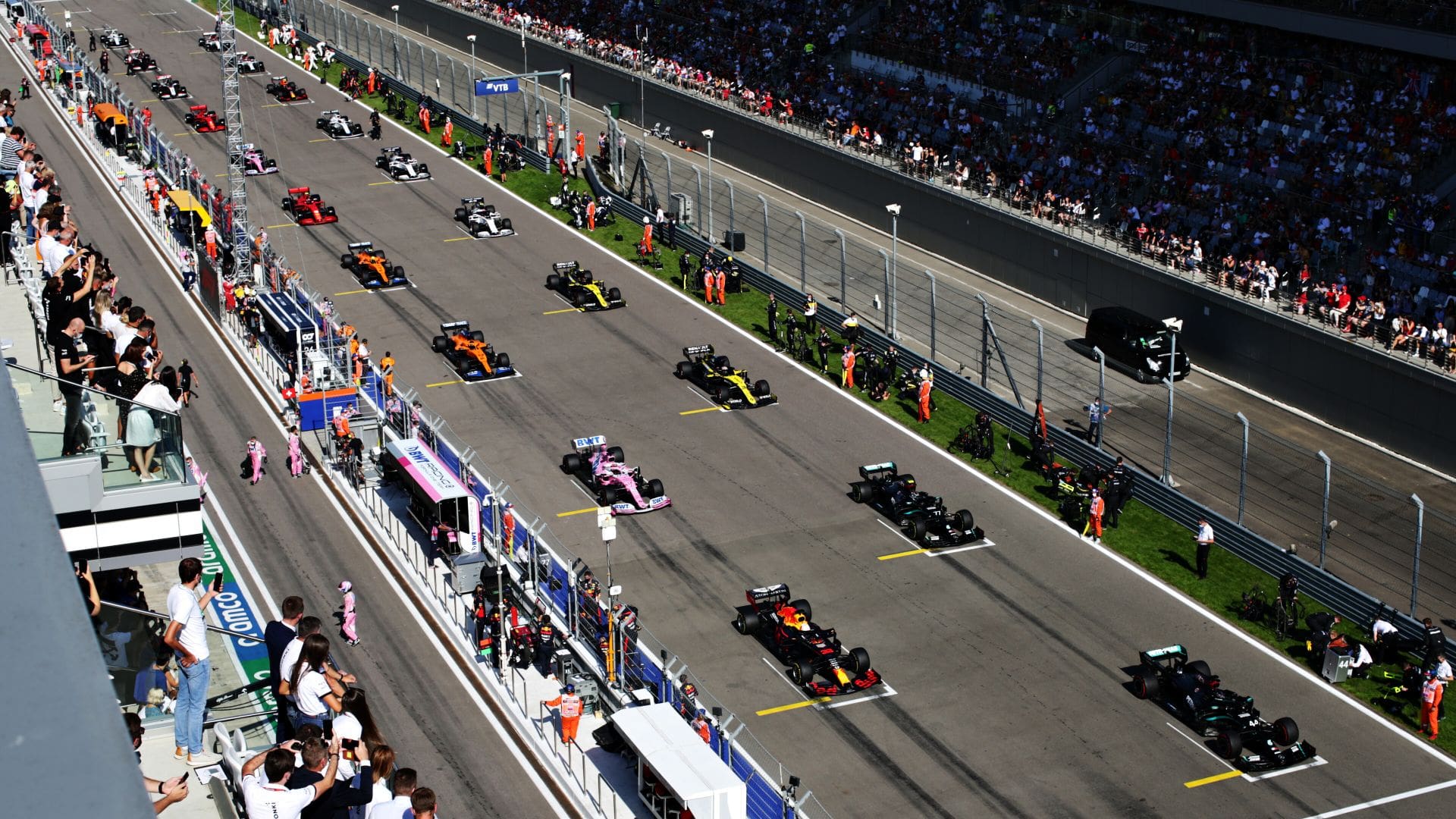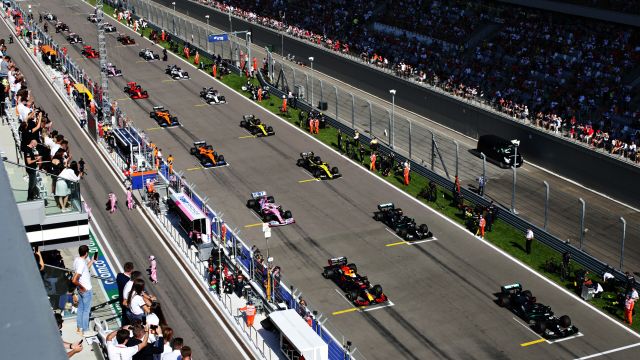What Is A Formation Lap In Formula 1?


You’ve seen it on TV or perhaps even at the track, the cars weaving back and forth before a Formula 1 race. The question arises in your mind, what is a Formation Lap in Formula 1?
The Formation Lap in Formula 1 is the lap before the race begins, during which drivers prepare their cars by warming up the tires, brakes, and engine, ensuring everything is working properly, and taking their positions on the starting grid.
In this article, we will explore the intricacies of the Formation Lap in Formula 1, delving into its purposes, what exactly happens during this vital pre-race ritual, and why it’s more than just a leisurely drive around the track. Whether you’re a new fan trying to understand the sport better or a seasoned enthusiast looking to deepen your knowledge, this comprehensive guide will help you appreciate the Formation Lap’s essential role in the spectacle that is Formula 1 racing.
Key Takeaways
- Formation lap is the initial lap in Formula One racing, helping drivers prepare for the race
- The lap allows drivers to warm up their cars and learn more about the track conditions
- Formation lap regulations ensure fairness and maintain safety in motorsport competitions
Understanding the Formation Lap
In Formula 1, the formation lap is an essential part of every Grand Prix event. It is often referred to as the parade lap or warm-up lap and takes place right before the actual race begins. The purpose of the formation lap is to provide drivers with an opportunity to warm up their tires, familiarize themselves with the track conditions, and carry out any final preparations before the start of the race.
During the formation lap, drivers line up on the grid according to their qualifying positions and follow the lead car, typically driven by a race marshal. As the drivers progress around the track at a controlled pace, they practice various heating and braking techniques to ensure their tyres reach optimal temperature. This is crucial for achieving maximum grip when the race commences.
Moreover, the formation lap allows drivers to assess the track and identify any possible changes in surface or conditions that may have occurred since the last time they were on the track. This information is crucial as it helps them adapt their driving strategies accordingly. In addition, by following the course during the formation lap, drivers can mentally prepare themselves for the difficult maneuvers and split-second decisions they will face once the race begins.
It is important to note that overtaking is strictly prohibited during the formation lap, and all drivers must maintain their original grid positions throughout its duration. Any deviation from this rule can lead to penalties, affecting their overall race performance.
In summary, the formation lap in Formula 1 is a crucial part of the Grand Prix event that serves to prepare each driver and their F1 car for the upcoming race. By allowing them to warm up their tires, assess the track, and get in the right mindset, the formation lap sets the stage for a safe and exciting race experience.
Purpose of the Formation Lap
Warming Up the Tires
The formation lap in Formula 1 serves a multitude of purposes that ultimately contribute to the success and safety of each race. One such purpose is warming up the tires. During the formation lap, drivers maneuver their Formula One cars in a way that generates heat within the tires. Warmer tires provide better grip on the track, which is essential for achieving a good start and maintaining control of the car during the race.
Assessing Track Conditions
Another purpose of the formation lap is for drivers to assess track conditions. By driving around the circuit before the race begins, they have an opportunity to identify any changes in the track surface or potential hazards that might impact their race performance. This also allows drivers to plan their strategies accordingly, particularly in terms of overtaking points and selecting the ideal racing line.
In summary, the formation lap is a critical pre-race ritual in Formula 1 that allows drivers to warm up their tires and assess track conditions, enabling them to optimize their performance and strategy for the race ahead.
The Process
Leaving the Pit Lane
During a Formula 1 race, the formation lap begins when the drivers leave the pit lane to head onto the track. This is an essential part of the pre-race procedure, as it allows the drivers to warm up their tires, brakes, and get a feel for the track conditions. As they navigate the circuit, the drivers weave from side to side, which generates heat in the tires and ensures optimal grip during the race.
Forming on the Grid
Once the drivers have completed the out lap from the pit lane, they will line up on the starting grid according to their qualifying positions. This orderly arrangement is vital for the smooth commencement of the race. While every Formula 1 car is stationary on the grid, the drivers must maintain their engines’ temperature to prevent overheating and remain focused on the race start.
Overtaking and Positioning
During the formation lap, overtaking is generally not allowed, with the exception of when a driver ahead is experiencing issues or is driving too slowly. In such cases, the driver who overtakes must regain their original starting position before reaching the beginning of the grid. Failure to reclaim the original place may result in penalties from race officials. It is crucial for the drivers to maintain their formation throughout the lap, ensuring a fair and equal start for all competitors.
In summary, the formation lap in Formula 1 serves various purposes, including warming up the tires, brakes, and engines, as well as familiarizing drivers with the track conditions. Each aspect, from leaving the pit lane to forming on the grid and obeying overtaking rules, contributes to a proper and safe race start.
Watch: Formula 1 Formation Lap Explained
In this video, F1 Education explains the intricacies of the F1 formation lap.
Is there a Formation Lap at Every F1 Race?
Yes, the Formation Lap is part of the standard starting procedure at every Formula 1 Grand Prix. It is an integral part of the race weekend, contributing to both the safety and excitement of the race.
Importance of the Formation Lap
The Formation Lap serves several vital functions that are crucial for both the drivers and the spectators. It ensures that the cars are in optimal condition as they line up on the grid, enhancing the competition’s fairness and intensity. Additionally, it adds to the spectacle of the race, building anticipation and allowing fans to observe the cars up close before the high-speed action commences.
Exceptions and Special Circumstances
While the Formation Lap is a standard practice, there may be exceptions or alterations in unique situations. For example, in the case of extreme weather conditions like heavy rain, additional formation laps might be conducted to assess the track’s safety. Conversely, the procedure may be modified or shortened if there are time constraints or other specific concerns.
Why Are Formation Laps Mandatory?
Formation Laps are mandatory in Formula 1 for several compelling reasons, each contributing to the safety, fairness, and overall enjoyment of the race. Here’s a detailed look at why this pre-race ritual is a required part of every Grand Prix:
Ensuring Safety
By allowing drivers to warm up their tires, brakes, and engines, the Formation Lap ensures that the cars are in optimal condition as the race begins. Cold tires and brakes can lead to decreased grip and performance, increasing the risk of accidents, especially in the crucial first lap. The Formation Lap helps minimize these risks by bringing the car’s components to their ideal operating temperatures.
Promoting Fair Competition
The Formation Lap provides a level playing field by giving all drivers an equal opportunity to prepare their cars for the race. Whether they’re starting at the front of the grid or the back, every driver has the same chance to get their vehicle ready, ensuring that the race’s outcome is determined by skill, strategy, and performance, not by chance or disadvantageous starting conditions.
Enhancing Spectacle and Engagement
Beyond the technical aspects, the Formation Lap adds to the excitement and anticipation of the race. Fans get a chance to see the cars up close, performing dynamic maneuvers as they weave and accelerate around the track. The tension builds as the drivers take their positions on the grid, heightening the thrill as the race’s start draws near.
Adhering to Regulations and Protocols
The Formation Lap is also part of the standardized procedures and regulations set by the FIA (Fédération Internationale de l’Automobile), the governing body for motorsport worldwide. Adhering to these rules ensures consistency across races and maintains the integrity of the sport.
In summary, the mandatory nature of the Formation Lap in Formula 1 is rooted in multifaceted reasons, ranging from safety and competitive fairness to enhancing the race’s spectacle. It’s a tradition that reflects the complex interplay of technology, skill, and entertainment that makes Formula 1 a premier motorsport.
What Happens if There’s an Incident During the Formation Lap?
The Formation Lap is not just a ceremonial event; it’s a critical phase where everything must go right to ensure a smooth start to the race. But what happens if there’s an incident during the Formation Lap? Here’s an exploration of the procedures and consequences:
Minor Incidents
Minor incidents, such as a driver spinning or going off track without significant damage, usually result in the driver rejoining the lap if possible. The driver must regain their original starting position before reaching the starting grid. Failure to do so might lead to penalties.
Major Incidents
A major incident, such as a crash that damages a car, can have more serious consequences:
Car Damage:
If a car sustains damage during the Formation Lap and cannot continue, it must be retired. The race will proceed without that car, and the grid will adjust accordingly.
Additional Formation Lap:
In some cases, if the incident causes a significant obstruction or requires track cleanup, race control may decide to abort the original Formation Lap and conduct another one. This ensures that the track is safe and clear for the race to begin.
Starting from the Pit Lane:
If a driver experiences a problem but the team can repair the car in time, the driver may be allowed to start the race from the pit lane. This is usually at the discretion of race control and is subject to specific rules and regulations.
Penalties:
If a driver is deemed responsible for an incident during the Formation Lap (for example, causing a collision with another car), they may receive penalties such as grid position demotions, time penalties, or even disqualification from the race, depending on the severity of the offense.
Safety Measures and Protocols
The safety measures in place during the Formation Lap, including the presence of safety and medical cars, ensure a rapid response to any incidents. The regulations governing the Formation Lap are detailed and provide guidance for a wide range of potential situations.
In conclusion, while incidents during the Formation Lap are rare, there are clear procedures and regulations to handle them. The priority is always the safety of the drivers and the integrity of the competition, with decisions made to minimize disruption while ensuring a fair and exciting race.
Regulations and Penalties
Pit Lane Speed Limit
In Formula 1, there is a specific speed limit that must be followed within the pit lane. This regulation is in place to ensure the safety of both drivers and team personnel. The pit lane speed limit varies depending on the track, but it is generally set between 60 to 80 km/h (37 to 50 mph). Failing to adhere to the speed limit may result in penalties such as drive-through or stop-and-go penalties, which can significantly affect a driver’s race position.
Retirement Scenario
A retirement scenario is when a driver is forced to retire from the race due to a technical issue, accident, or other reasons. When a driver retires, their car is removed from the track as quickly and safely as possible. The remaining drivers must continue the race in the same order as before the retirement occurs, maintaining their positions unless overtaking is permitted. Penalties may be applied to drivers if they fail to respect regulations around retirement scenarios.
Incident Management
Incidents may occur during a Formula 1 race, such as collisions or technical issues that require on-track intervention. The stewards have the authority to investigate and manage incidents, applying penalties if necessary. Penalties for incidents can be applied depending on the severity, ranging from five-second or ten-second time penalties to more severe consequences such as disqualification.
When an incident occurs, the stewards have various tools at their disposal to manage the situation. These can include deploying the Safety Car, Virtual Safety Car, or using yellow flags to warn drivers and enforce speed restrictions. A red flag can be used to temporarily stop the race. Drivers must respect the regulations set forth by the stewards and adhere to any instructions given during incident management to avoid further penalties.
When Did F1 First Start Having Formation Laps?
The Formation Lap, a well-established and crucial aspect of modern Formula 1 racing, has its roots in the 1970s. Let’s explore how this tradition began and why it became an integral part of the sport.
Introduction in the 1970s
Formation Laps were first introduced in Formula 1 in the 1970s. This period was marked by significant changes in both technology and safety regulations within the sport. The idea behind the Formation Lap was to give drivers the opportunity to warm up their cars’ tires, brakes, and engines, ensuring they were at optimal performance levels before the start of the race.
Rationale Behind the Introduction
The decision to introduce Formation Laps was influenced by several factors, including:
Safety Concerns: The 1970s were a time of growing emphasis on safety in motorsports. By allowing drivers to warm up their vehicles, the Formation Lap reduced the risks associated with cold tires and brakes, which could lead to decreased grip and control.
Technological Advancements: As car technology advanced, the complexities of preparing a car for a race also grew. The Formation Lap provided a structured way to ensure that all systems were working properly before the intense competition began.
Fair Competition: The Formation Lap also served to level the playing field, ensuring that every driver had an equal opportunity to prepare their car for the race.
Standardization and Evolution
Over time, the Formation Lap’s procedures and rules were standardized and refined. What started as a simple warm-up lap became a carefully choreographed and regulated part of the race weekend, with specific guidelines covering everything from tire warming to grid positioning.
The FIA (Fédération Internationale de l’Automobile), Formula 1’s governing body, continued to evolve the rules around the Formation Lap, reflecting changes in technology, safety standards, and the sport’s competitive nature.
Frequently Asked Questions
Why is there a formation lap in F1?
The formation lap in Formula 1 is a crucial part of the race start procedure. It allows drivers to warm up their tires and brakes, perform last-minute checks, and establish the correct starting order. The formation lap plays a vital role in ensuring optimal race conditions and reducing the risk of accidents or issues at the start of the race.
F1 formation lap rules
During the formation lap, drivers are required to maintain their qualifying order behind the driver in pole position as they make their way around the track. They must not overtake other cars, unless a car ahead is in trouble and has slowed down significantly. Drivers are also not allowed to excessively weave or make sudden movements, as this can cause accidents or affect the integrity of the starting grid.
F1 formation lap crash
In the rare event of a crash or incident during the formation lap, the race start may be delayed or even aborted. Race officials and the race director will assess the situation and determine the appropriate course of action, which may involve a new formation lap or a full restart of the race.
Formation lap meaning
The formation lap, also known as the warm-up, reconnaissance lap, or parade lap, is an essential pre-race process in Formula 1. It ensures that the cars are lined up correctly on the starting grid, and it gives drivers the opportunity to prepare their vehicles for optimal race conditions.
Does F1 always do a formation lap?
Yes, a formation lap is a standard procedure in Formula 1 that takes place before every race. It is a vital part of the race start process, allowing drivers to warm their tires and brakes, check their vehicle’s systems, and establish their position on the grid.
Can F1 drivers talk on formation lap?
F1 drivers are allowed to communicate with their team during the formation lap. They use the team radio to relay important information regarding their car’s condition, track conditions, and potential issues or concerns. This communication helps ensure that the drivers and their teams are fully prepared for the race start. Two-time World Champion Max Verstappen likes to talk with his team during a formation lap, while Lewis Hamilton prefers silence so he can focus on the race start.





